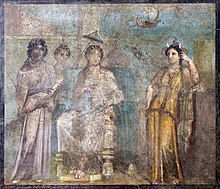
Back Affrica (duwies) Welsh África (mitología) Spanish Africa (déesse) French Африка (римская мифология) Russian Африка (богиња) Serbian Африка (богиня) Ukrainian



The Goddess Africa, in Latin Dea Africa, was the personification of Africa by the Romans in the early centuries of the common era.[1][2] She was one of the fertility and abundance deities to some. Her iconography typically included an elephant-mask head dress, a cornucopia, a military standard, and a lion.[3]
To the Romans "Africa" was only their imperial province, roughly equating to modern Tunisia, and the goddess/personification was not given sub-Saharan African characteristics; she was possibly thought of as Berber, but this cannot be judged in the great majority of representations. This changed after she was revived in the Renaissance, by now clearly only the personification of Africa with no divine pretensions.[citation needed]
- ^ a b Gifty Ako-Adounvo (1999), Studies in the Iconography of Blacks in Roman Art, Ph.D. Thesis awarded by McMaster University, Thesis Advisor: Katherine Dunbabin, page 82
- ^ Christine Hamdoune (2008), La dea Africa et le culte impérial[permanent dead link], Études d'antiquités africaines, Volume 1, Numéro 1, pages 151-161
- ^ Paul Lachlan MacKendrick (2000). The North African Stones Speak. University of North Carolina Press. p. 236. ISBN 978-0-8078-4942-2.
© MMXXIII Rich X Search. We shall prevail. All rights reserved. Rich X Search